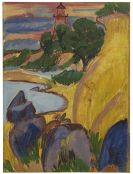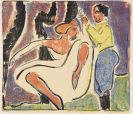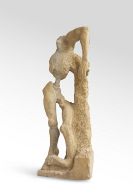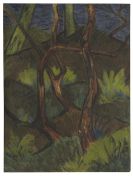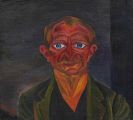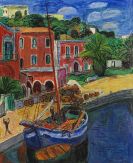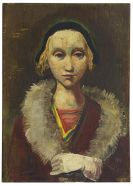
Ernst Hassebrauk
Dresden
1905 -
Dresden
1974
Ernst Hassebrauk was born in Dresden on 28 June 1905. After taking the examinations that qualified for university entrance, Ernst Hassebrauk attended the State Academy for the Decorative and Applied Arts and the Polytechnic in Dresden from 1925 to 1927 before studying at the Leipzig Academy for the Graphic Arts and Book Design, where he was in Willi Geiger's master class. Hassebrauk also finished studies in art history and philosophy in 1927-29 at Leipzig University and worked as a drawing master.
Hassebrauk's first employment was in the Prints Cabinet at the Leipzig "Museum der Bildenden Künste". During the 1930s Hassebrauk travelled extensively in southern Germany and the Netherlands, where he visited numerous museums and an important Frans Hals exhibition in Haarlem. In 1938 Hassebrauk moved to Dresden-Loschwitz.
During the second world war Ernst Hassebrauk succeeded Woldemar Winkler as an instructor at a private painting and drawing school. Hassebrauk was in the garrison at Glauchau when the war ended; enduring great hardship, he made his way to Leipzig and then Dresden.
Will Grohmann, by then a cultural administration official, placed a studio at Brühlsche Terrasse at Hassebrauk's disposal. A year later, in 1946, Hassebrauk taught at the Leipzig Academy for the Graphic Arts and Book Design, where he was appointed professor in 1947. After being discharged from his position in 1949, Hassebrauk returned to Leipzig as a freelance artist, painting numerous landscapes and urban scenes notable for vibrant colour contrasts and an impulsively sketchy style.
In 1953 Hassebrauk had his first post-war show, at the "Städtischen Kunstsammlungen" Görlitz, which was followed by further exhibitions of his work in the GDR and West Germany, including annual participation in the "Große Münchner Kunstausstellung" in Munich. In 1958 Hassebrauk painted at the port of Hamburg before going on to Munich, where the "European Rococo" exhibition greatly impressed him.
Ernst Hassebrauk spent time in the Bavaria capital sketching at museums and castles. From 1958 he began to focus on adapting earlier art of all genres. Long awaited, his "Dresdner Bilderbuch" was published in 1968; the text was by Fritz Löffler.
That year Ernst Hassebrauk went to Hungary for the first time, returning twice before his death in Dresden on 30 August 1974. Ernst Hassebrauk's legacy is comprehensive and varied, oscillating between the Impressionist and the Expressionist traditions and informed by a consistent preoccupation with the Dutch and Flemish Old Masters.
Would you like to sell a work by Ernst Hassebrauk?
Infos for seller
